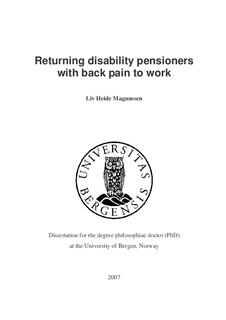| dc.description.abstract | The main purpose of this thesis was to investigate whether a group of disability pensioners with back pain would have a potential for a successful return to work. Perceived barriers against work, physical and mental functioning and the effect of a vocational- oriented intervention were evaluated. The thesis consists of three papers. The first paper deals with the pensioners’ perceived barriers against work and perceptions of their own health. This was considered likely to have an impact on the process of returning to work. To explore these perceptions, focus group interviews in a sample of 17 disability pensioners were carried out. Several perceived barriers against a successful return to work appeared: earlier negative experiences related to the disability process and previous work, poor self - judgement of work ability, low self-esteem, lack of support from social security authorities and unsuitable economic arrangements. The second paper explores whether the level of physical and mental functioning would influence on a successful return to work in patients on disability pension due to back pain. Both self-report and physical performance measures disclosed considerably reduced physical functioning among these disability pensioners. High levels of pain, fear avoidance beliefs, emotional distress and other health complaints were also reported. The majority rated their working ability as poor and did not expect that they could ever return to work. However, a subgroup with a more positive expectancy was found. In this group we found a better physical and mental functioning. In the third paper, a randomised controlled trial was conducted to evaluate the effect of a brief vocational-oriented intervention. The intervention focused on the issues emerging from Paper 1 and 2. The intervention had no statistically significant effect on return to work during the following year. However, twice as many in the intervention group as in the control group had entered into a return to work process at 1-year follow-up which gave a number needed to treat of 9. Prognostic factors for having entered this process included a more positive expectancy for a return to work, less pain and better physical performance. This thesis confirms that the effort of returning disability pensioners with back pain to work is a challenging task. Due to the large economical implication of returning disability pensioners to work, the modest effect of the intervention used in the present study may still be of clinical and economical relevance, at least for a selected group of pensioners. Candidates for vocational rehabilitation seem to be more likely to succeed if they have a positive attitude towards returning to work, have less pain and when they are not severely physically impaired. Candidates in future rehabilitation programmes should probably be selected based on these criteria. They seem also to need very close follow-up from all parts involved in the return to work process. | en_US |



